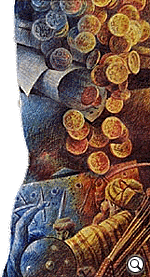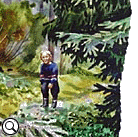 Everyone
can well imagine the destruction such a carriage would wreak
amid the ranks of Grand Turkey if one sat in it, charged
the enemy and drove around a few times. One could do it
just to pass the time or as if taking a normal drive: the
driver would be completely safe in his metal fortress. If
one of the enemy should be spared getting cut in two by
the sharp scythes, the driver inside could easily shoot
him. This incomparable stroke of human genius seems to have
amused the Czar greatly, for he ordered a prize of 500 rubles
to be paid to Viiliäinen. It is no wonder, then, after such
glorious success, Viiliäinen, both while awake and asleep,
is thinking of new inventions. It is hard to say how far
he might have gotten; he might have even found the way to
the moon in the end if not to other planets if he had not,
to his great misfortune, developed, shall we say, some mental
problems. Following this terribly sad development, he could
not pursue any of his bold undertakings, such as trying
to get to the moon, because he knows he shouldn't try to
fly higher than his wings will carry him...
Everyone
can well imagine the destruction such a carriage would wreak
amid the ranks of Grand Turkey if one sat in it, charged
the enemy and drove around a few times. One could do it
just to pass the time or as if taking a normal drive: the
driver would be completely safe in his metal fortress. If
one of the enemy should be spared getting cut in two by
the sharp scythes, the driver inside could easily shoot
him. This incomparable stroke of human genius seems to have
amused the Czar greatly, for he ordered a prize of 500 rubles
to be paid to Viiliäinen. It is no wonder, then, after such
glorious success, Viiliäinen, both while awake and asleep,
is thinking of new inventions. It is hard to say how far
he might have gotten; he might have even found the way to
the moon in the end if not to other planets if he had not,
to his great misfortune, developed, shall we say, some mental
problems. Following this terribly sad development, he could
not pursue any of his bold undertakings, such as trying
to get to the moon, because he knows he shouldn't try to
fly higher than his wings will carry him...
Of course, as you see, I have gone on excessively about
our friend Viiliäinen but now I am leaving his company and
we will be in Jonkeri in a minute, which has been a 60 km
journey through the wilderness. As you know, several decades
ago, some children skied all the way from Jonkeri to Nurmes
to have themselves baptized. We spent the night in a house
there and then made our way up to Saunajärvi, where I parted
company with my fellow wanderers, who had no intention of
crossing over into Russia. After travelling for an hour,
first by water and then by land, I came to Niskavaara -
so wet from a downpour that you would think I had spent
the day in water. From here I had to go on to Ukonvaara,
which they say is 3 km  away.
A little boy no older than five or six - the older folks
were gone - guided me a little way along the path. He told
me to turn right here and left there and then left me. I
followed his directions carefully as far as when to turn
was concerned, but didn't know which direction I should
turn in. After walking quite a way, I came to a farm called
Losola or Losonvaara. I still had 2 km to go to Ukonvaara
and it was another six to Kuusjärvi, where I arrived very
late in the evening. The next morning I left there and hired
a guide to take me to Kolvasjärvi, which was the first village
on the Russian side and a good 20 km off.
away.
A little boy no older than five or six - the older folks
were gone - guided me a little way along the path. He told
me to turn right here and left there and then left me. I
followed his directions carefully as far as when to turn
was concerned, but didn't know which direction I should
turn in. After walking quite a way, I came to a farm called
Losola or Losonvaara. I still had 2 km to go to Ukonvaara
and it was another six to Kuusjärvi, where I arrived very
late in the evening. The next morning I left there and hired
a guide to take me to Kolvasjärvi, which was the first village
on the Russian side and a good 20 km off.